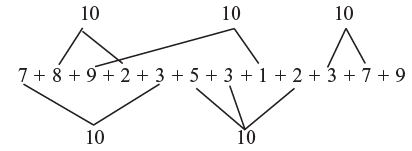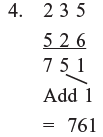Tips and Tricks: Addition | Improve Your Calculations: Vedic Maths (English) - Class 6 PDF Download
Introduction
Addition is the most basic operation and adding number 1 to the previous number generates all the numbers. The Sutra “By one more than the previous one describes the generation of numbers from unity.
0 + 1 = 1
1 + 1 = 2
2 + 1 = 3
3 + 1 = 4
4 + 1 = 5
5 + 1 = 6
6 + 1 = 7
7 + 1 = 8
8 + 1 = 9
9 + 1 = 10......
Completing the whole method
8 close to 10
9 close to 10
17, 18, 19, are close to 20
27, 28, 29, are close to 30
37, 38, 39, are close to 40
47, 48, 49, are close to 50
57, 58, 59, are close to 60
67, 68, 69, are close to 70
77, 78, 79, are close to 80
87, 88, 89, are close to 90
97, 98, 99, are close to 100 ...............
and so on
We can use this closeness to find addition and subtraction.
The Ten Point Circle
 We can easily say that 9 is close to 10, 19 is close to 20 etc.
We can easily say that 9 is close to 10, 19 is close to 20 etc.
Rule: By completion non-completion
Five number pairs:
1 + 9
2 + 8
3 + 7
4 + 6
5 + 5
Use these number pairs to make groups of '10' when adding numbers. Example: 24 + 26 = 20 + 4 + 20 + 6 = 20 + 20 + 10 = 50
Example: 24 + 26 = 20 + 4 + 20 + 6 = 20 + 20 + 10 = 50
Below a multiple of ten
Rule: By the deficiency
49 is close to 50 and is 1 short.
38 is close to 40 and is 2 short.
Example: 59 + 4 = 59 + 1 + 3 = 60 + 3 = 63 {59 is close to 60 and 1 short 50, 59 + 4 is 60}
Example: 38 + 24 = 38 + 2 + 22 = 40 + 22 = 62
or
38 + 24 = 40 + 24 – 2 = 64 – 2 = 62
{38 is close and is 2 sheet so, 38 + 24 is 2 short from 40 + 24 hence 38 + 24 = 40 + 24 – 2 = 64 – 2 = 62}
Example: Add 39 + 6 = ? 39 is close to 40 and is 1 less then it.
So we take 1 from the 6 to make up 40 and then we have 5 more to add on which gives 45
Add
29 + 18 + 3 [As 3 = 1 + 2 and 29 + 1 = 30, 18 + 2 = 20]
[As 3 = 1 + 2 and 29 + 1 = 30, 18 + 2 = 20]
30 + 20 = 50
Note: We break 3 into 1 + 2 because 29 need 1 to become 30 and 18 need 2 become 20]
Add
39 + 8 + 1 + 4
39 + 8 + 1 + 2 + 2
40 + 10 + 2 = 52
Sum of Ten
The ten point circle illustrates the pairs of numbers whose sum is 10.
Remember: There are eight unique groups of three number that sum to 10, for example 1 + 2 + 7 = 10
Can you find the other seven groups of three number summing to 10 as one example given for you?
Adding a list of numbers
Rule: By completion or non-completion
Look for number pairs that make a multiple of 10
7 + 6 + 3 + 4
The list can be sequentially added as follows:
7 + 6 = 13 then 13 + 3 = 16 then 16 + 4 = 20
Or
You could look for number pairs that make multiples of 10.
7 + 3 is 10 and 6 + 4 is 10
hence 10 + 10 is 20.
Similarly:
= (48 + 32) + (16 + 1 + 60)
= 80 + 77 = 157
or
= 10 + 10 + 10 + 10 + 10 + 9 = 59
Adding from left to right
The conventional methods of mathematics teachers use to do calculation from right and working towards the left.
In Vedic mathematics we can do addition from left to right which is more, useful, easier and sometimes quicker.
Add from left to right:



The method: This is easy enough to do mentally, we add the first column and increase this by 1 if there is carry coming over from the second column. Then we tag the last figure of the second column onto this
Shudh method for a list of number
Shudh means pure. The pure numbers are the single digit numbers i.e. 0, 1, 2, 3…9. In Shudh method of addition we drop the 1 at the tens place and carry only the single digit forward.
Example: Find 2 + 7 + 8 + 9 + 6 + 4
We start adding from bottom to top because that is how our eyes naturally move but it is not necessary we can start from top to bottom. As soon as we come across a two-digit number, we put a dot instead of one and carry only the single digit forward for further addition. We put down the single digit (6 in this case) that we get in the end. For the first digit, we add all the dots (3 in this case) and write it.
Adding two or three-digit numbers list
. 23.4 We start from the bottom of the right most columns and get a single digit 6 at the unit
6.5.8 place. There are two dots so we add two to the first number (4) of
.81.8 the second column and proceed as before. The one dot of this
46 column is added to the next and in the end we just put 1 down
1756 (for one dot) as the first digit of the answer.
(Shudh method)


Number Splitting Method
Quick mental calculations can be performed more easily if the numbers are 'split into more manageable parts.
For example: Split into two more manageable sums
Note: The split allows us to add 36 + 24 and 42 + 39 both of which can be done mentally
Remember: Think about where to place the split line. It's often best to avoid number 'carries' over the line.
For example:
A carry of '1' over the line is required
|
38 videos|31 docs|9 tests
|
















